Comparative Analysis: Germany's Healthcare System and Policies
VerifiedAdded on 2021/02/19
|10
|3014
|31
Report
AI Summary
This report provides a comprehensive analysis of the German healthcare system, examining its policies, initiatives, and challenges. It begins with an introduction to healthcare systems and then focuses on Germany, a country with a robust economy and a universal, multi-payer healthcare system. The report details the governance, financing, and medicine aspects of the German system, including the role of the Federal Joint Committee, government funding, and the pharmaceutical industry. It also covers major diagnoses, the availability of hospitals and clinics, and insurance requirements. The report highlights both the benefits of the system, such as patient choice and special benefits for students, and the difficulties, like potential impacts of private and public healthcare. The analysis includes healthcare statistics, comparisons to the European Union model, and discussions on social determinants of non-communicable diseases. The report also touches upon common health service complaints and the country's efforts in disease preparedness, including the recent WHO support for potential outbreaks. The report concludes by summarizing the key aspects of the German healthcare system, its strengths, and the ongoing challenges it faces.

HEALTH SYSTEM
Paraphrase This Document
Need a fresh take? Get an instant paraphrase of this document with our AI Paraphraser
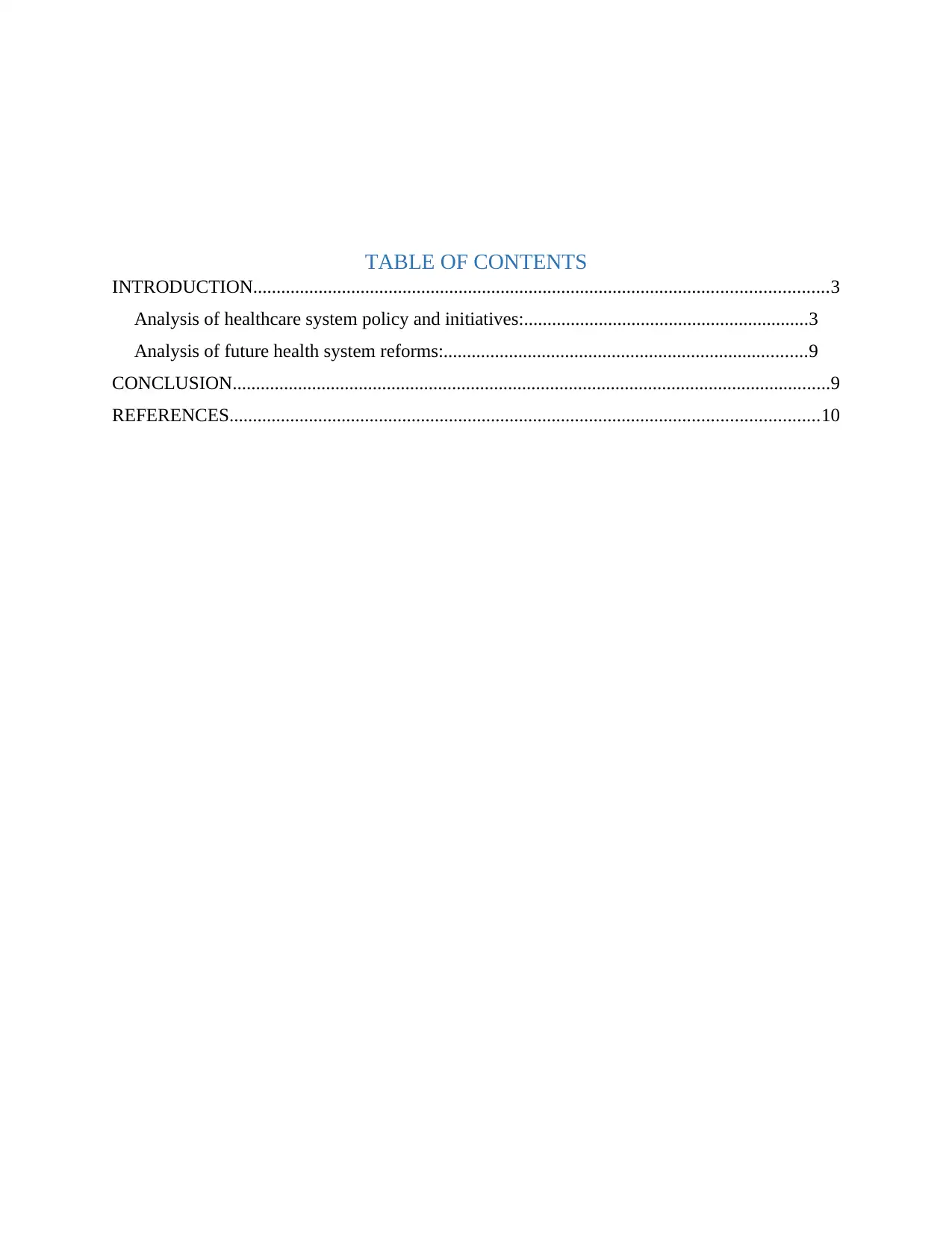
TABLE OF CONTENTS
INTRODUCTION...........................................................................................................................3
Analysis of healthcare system policy and initiatives:.............................................................3
Analysis of future health system reforms:..............................................................................9
CONCLUSION................................................................................................................................9
REFERENCES..............................................................................................................................10
INTRODUCTION...........................................................................................................................3
Analysis of healthcare system policy and initiatives:.............................................................3
Analysis of future health system reforms:..............................................................................9
CONCLUSION................................................................................................................................9
REFERENCES..............................................................................................................................10
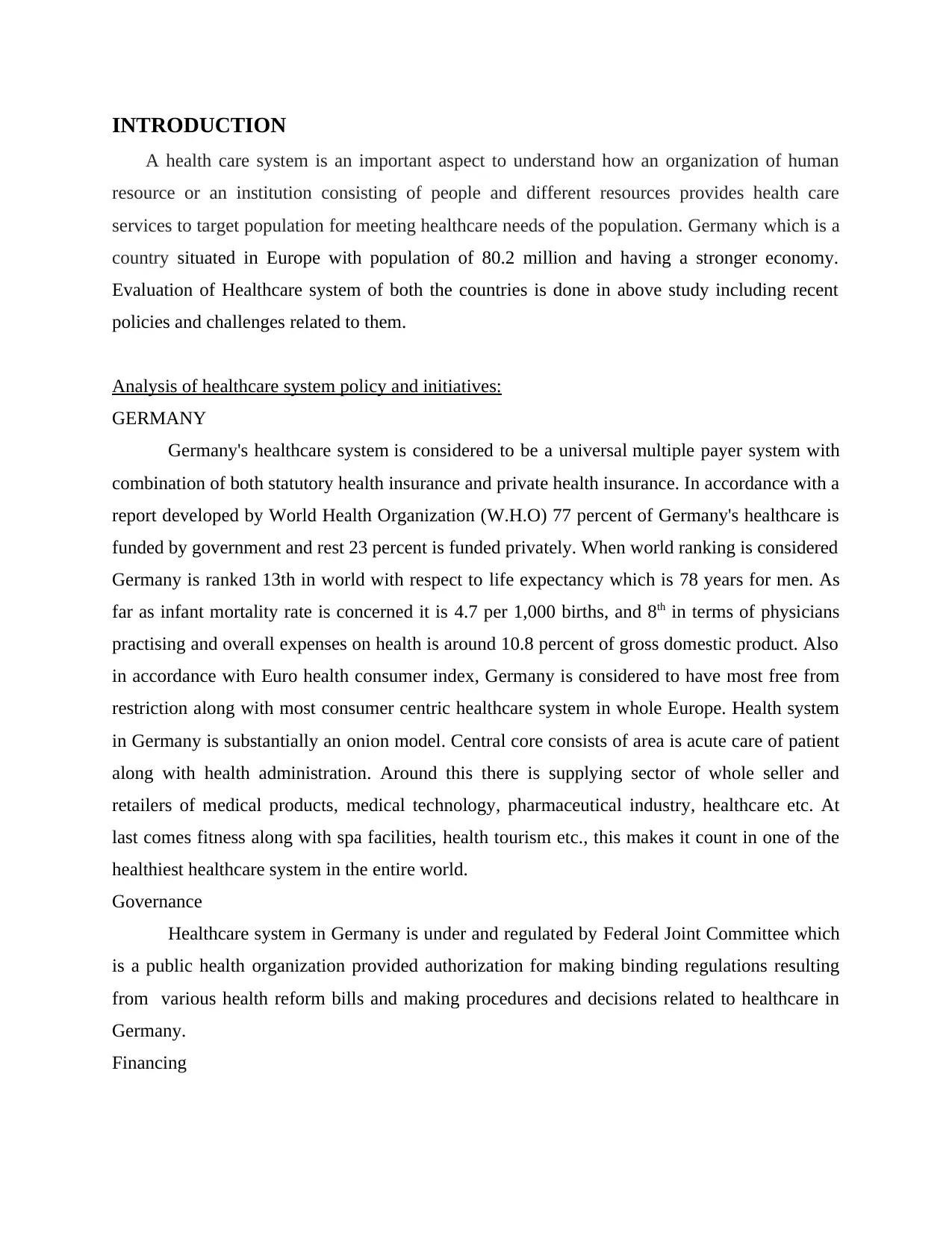
INTRODUCTION
A health care system is an important aspect to understand how an organization of human
resource or an institution consisting of people and different resources provides health care
services to target population for meeting healthcare needs of the population. Germany which is a
country situated in Europe with population of 80.2 million and having a stronger economy.
Evaluation of Healthcare system of both the countries is done in above study including recent
policies and challenges related to them.
Analysis of healthcare system policy and initiatives:
GERMANY
Germany's healthcare system is considered to be a universal multiple payer system with
combination of both statutory health insurance and private health insurance. In accordance with a
report developed by World Health Organization (W.H.O) 77 percent of Germany's healthcare is
funded by government and rest 23 percent is funded privately. When world ranking is considered
Germany is ranked 13th in world with respect to life expectancy which is 78 years for men. As
far as infant mortality rate is concerned it is 4.7 per 1,000 births, and 8th in terms of physicians
practising and overall expenses on health is around 10.8 percent of gross domestic product. Also
in accordance with Euro health consumer index, Germany is considered to have most free from
restriction along with most consumer centric healthcare system in whole Europe. Health system
in Germany is substantially an onion model. Central core consists of area is acute care of patient
along with health administration. Around this there is supplying sector of whole seller and
retailers of medical products, medical technology, pharmaceutical industry, healthcare etc. At
last comes fitness along with spa facilities, health tourism etc., this makes it count in one of the
healthiest healthcare system in the entire world.
Governance
Healthcare system in Germany is under and regulated by Federal Joint Committee which
is a public health organization provided authorization for making binding regulations resulting
from various health reform bills and making procedures and decisions related to healthcare in
Germany.
Financing
A health care system is an important aspect to understand how an organization of human
resource or an institution consisting of people and different resources provides health care
services to target population for meeting healthcare needs of the population. Germany which is a
country situated in Europe with population of 80.2 million and having a stronger economy.
Evaluation of Healthcare system of both the countries is done in above study including recent
policies and challenges related to them.
Analysis of healthcare system policy and initiatives:
GERMANY
Germany's healthcare system is considered to be a universal multiple payer system with
combination of both statutory health insurance and private health insurance. In accordance with a
report developed by World Health Organization (W.H.O) 77 percent of Germany's healthcare is
funded by government and rest 23 percent is funded privately. When world ranking is considered
Germany is ranked 13th in world with respect to life expectancy which is 78 years for men. As
far as infant mortality rate is concerned it is 4.7 per 1,000 births, and 8th in terms of physicians
practising and overall expenses on health is around 10.8 percent of gross domestic product. Also
in accordance with Euro health consumer index, Germany is considered to have most free from
restriction along with most consumer centric healthcare system in whole Europe. Health system
in Germany is substantially an onion model. Central core consists of area is acute care of patient
along with health administration. Around this there is supplying sector of whole seller and
retailers of medical products, medical technology, pharmaceutical industry, healthcare etc. At
last comes fitness along with spa facilities, health tourism etc., this makes it count in one of the
healthiest healthcare system in the entire world.
Governance
Healthcare system in Germany is under and regulated by Federal Joint Committee which
is a public health organization provided authorization for making binding regulations resulting
from various health reform bills and making procedures and decisions related to healthcare in
Germany.
Financing
⊘ This is a preview!⊘
Do you want full access?
Subscribe today to unlock all pages.

Trusted by 1+ million students worldwide
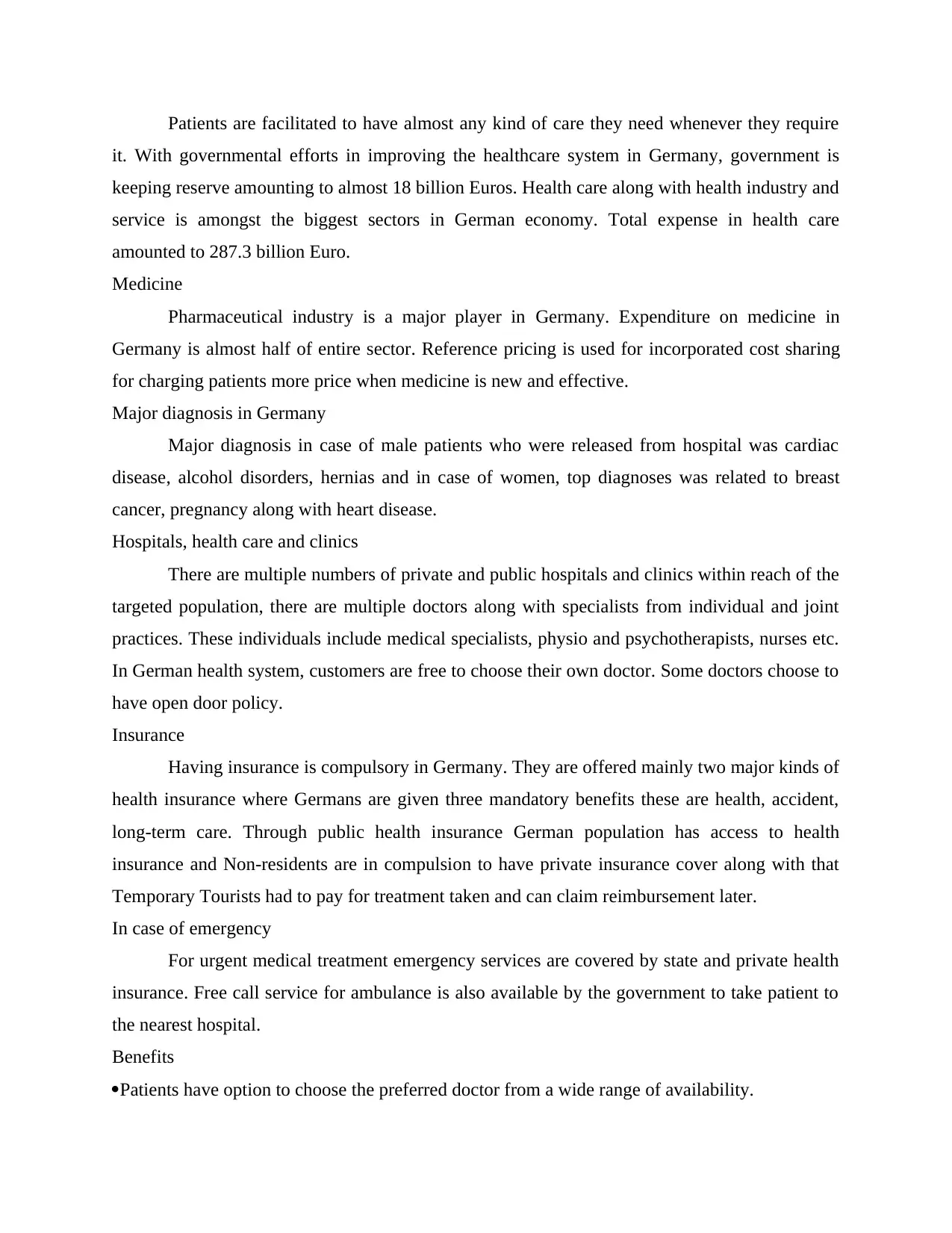
Patients are facilitated to have almost any kind of care they need whenever they require
it. With governmental efforts in improving the healthcare system in Germany, government is
keeping reserve amounting to almost 18 billion Euros. Health care along with health industry and
service is amongst the biggest sectors in German economy. Total expense in health care
amounted to 287.3 billion Euro.
Medicine
Pharmaceutical industry is a major player in Germany. Expenditure on medicine in
Germany is almost half of entire sector. Reference pricing is used for incorporated cost sharing
for charging patients more price when medicine is new and effective.
Major diagnosis in Germany
Major diagnosis in case of male patients who were released from hospital was cardiac
disease, alcohol disorders, hernias and in case of women, top diagnoses was related to breast
cancer, pregnancy along with heart disease.
Hospitals, health care and clinics
There are multiple numbers of private and public hospitals and clinics within reach of the
targeted population, there are multiple doctors along with specialists from individual and joint
practices. These individuals include medical specialists, physio and psychotherapists, nurses etc.
In German health system, customers are free to choose their own doctor. Some doctors choose to
have open door policy.
Insurance
Having insurance is compulsory in Germany. They are offered mainly two major kinds of
health insurance where Germans are given three mandatory benefits these are health, accident,
long-term care. Through public health insurance German population has access to health
insurance and Non-residents are in compulsion to have private insurance cover along with that
Temporary Tourists had to pay for treatment taken and can claim reimbursement later.
In case of emergency
For urgent medical treatment emergency services are covered by state and private health
insurance. Free call service for ambulance is also available by the government to take patient to
the nearest hospital.
Benefits
Patients have option to choose the preferred doctor from a wide range of availability.
it. With governmental efforts in improving the healthcare system in Germany, government is
keeping reserve amounting to almost 18 billion Euros. Health care along with health industry and
service is amongst the biggest sectors in German economy. Total expense in health care
amounted to 287.3 billion Euro.
Medicine
Pharmaceutical industry is a major player in Germany. Expenditure on medicine in
Germany is almost half of entire sector. Reference pricing is used for incorporated cost sharing
for charging patients more price when medicine is new and effective.
Major diagnosis in Germany
Major diagnosis in case of male patients who were released from hospital was cardiac
disease, alcohol disorders, hernias and in case of women, top diagnoses was related to breast
cancer, pregnancy along with heart disease.
Hospitals, health care and clinics
There are multiple numbers of private and public hospitals and clinics within reach of the
targeted population, there are multiple doctors along with specialists from individual and joint
practices. These individuals include medical specialists, physio and psychotherapists, nurses etc.
In German health system, customers are free to choose their own doctor. Some doctors choose to
have open door policy.
Insurance
Having insurance is compulsory in Germany. They are offered mainly two major kinds of
health insurance where Germans are given three mandatory benefits these are health, accident,
long-term care. Through public health insurance German population has access to health
insurance and Non-residents are in compulsion to have private insurance cover along with that
Temporary Tourists had to pay for treatment taken and can claim reimbursement later.
In case of emergency
For urgent medical treatment emergency services are covered by state and private health
insurance. Free call service for ambulance is also available by the government to take patient to
the nearest hospital.
Benefits
Patients have option to choose the preferred doctor from a wide range of availability.
Paraphrase This Document
Need a fresh take? Get an instant paraphrase of this document with our AI Paraphraser
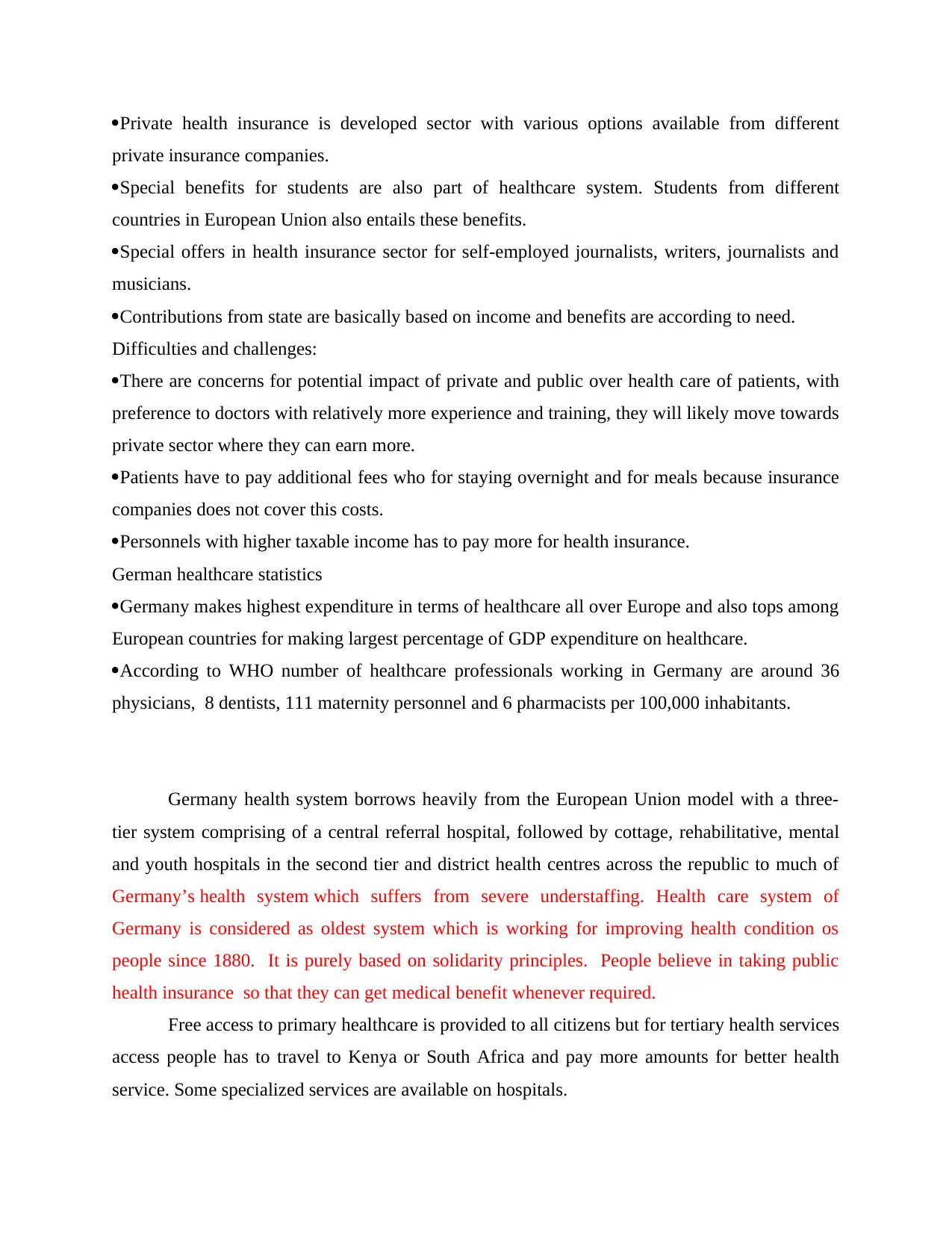
Private health insurance is developed sector with various options available from different
private insurance companies.
Special benefits for students are also part of healthcare system. Students from different
countries in European Union also entails these benefits.
Special offers in health insurance sector for self-employed journalists, writers, journalists and
musicians.
Contributions from state are basically based on income and benefits are according to need.
Difficulties and challenges:
There are concerns for potential impact of private and public over health care of patients, with
preference to doctors with relatively more experience and training, they will likely move towards
private sector where they can earn more.
Patients have to pay additional fees who for staying overnight and for meals because insurance
companies does not cover this costs.
Personnels with higher taxable income has to pay more for health insurance.
German healthcare statistics
Germany makes highest expenditure in terms of healthcare all over Europe and also tops among
European countries for making largest percentage of GDP expenditure on healthcare.
According to WHO number of healthcare professionals working in Germany are around 36
physicians, 8 dentists, 111 maternity personnel and 6 pharmacists per 100,000 inhabitants.
Germany health system borrows heavily from the European Union model with a three-
tier system comprising of a central referral hospital, followed by cottage, rehabilitative, mental
and youth hospitals in the second tier and district health centres across the republic to much of
Germany’s health system which suffers from severe understaffing. Health care system of
Germany is considered as oldest system which is working for improving health condition os
people since 1880. It is purely based on solidarity principles. People believe in taking public
health insurance so that they can get medical benefit whenever required.
Free access to primary healthcare is provided to all citizens but for tertiary health services
access people has to travel to Kenya or South Africa and pay more amounts for better health
service. Some specialized services are available on hospitals.
private insurance companies.
Special benefits for students are also part of healthcare system. Students from different
countries in European Union also entails these benefits.
Special offers in health insurance sector for self-employed journalists, writers, journalists and
musicians.
Contributions from state are basically based on income and benefits are according to need.
Difficulties and challenges:
There are concerns for potential impact of private and public over health care of patients, with
preference to doctors with relatively more experience and training, they will likely move towards
private sector where they can earn more.
Patients have to pay additional fees who for staying overnight and for meals because insurance
companies does not cover this costs.
Personnels with higher taxable income has to pay more for health insurance.
German healthcare statistics
Germany makes highest expenditure in terms of healthcare all over Europe and also tops among
European countries for making largest percentage of GDP expenditure on healthcare.
According to WHO number of healthcare professionals working in Germany are around 36
physicians, 8 dentists, 111 maternity personnel and 6 pharmacists per 100,000 inhabitants.
Germany health system borrows heavily from the European Union model with a three-
tier system comprising of a central referral hospital, followed by cottage, rehabilitative, mental
and youth hospitals in the second tier and district health centres across the republic to much of
Germany’s health system which suffers from severe understaffing. Health care system of
Germany is considered as oldest system which is working for improving health condition os
people since 1880. It is purely based on solidarity principles. People believe in taking public
health insurance so that they can get medical benefit whenever required.
Free access to primary healthcare is provided to all citizens but for tertiary health services
access people has to travel to Kenya or South Africa and pay more amounts for better health
service. Some specialized services are available on hospitals.
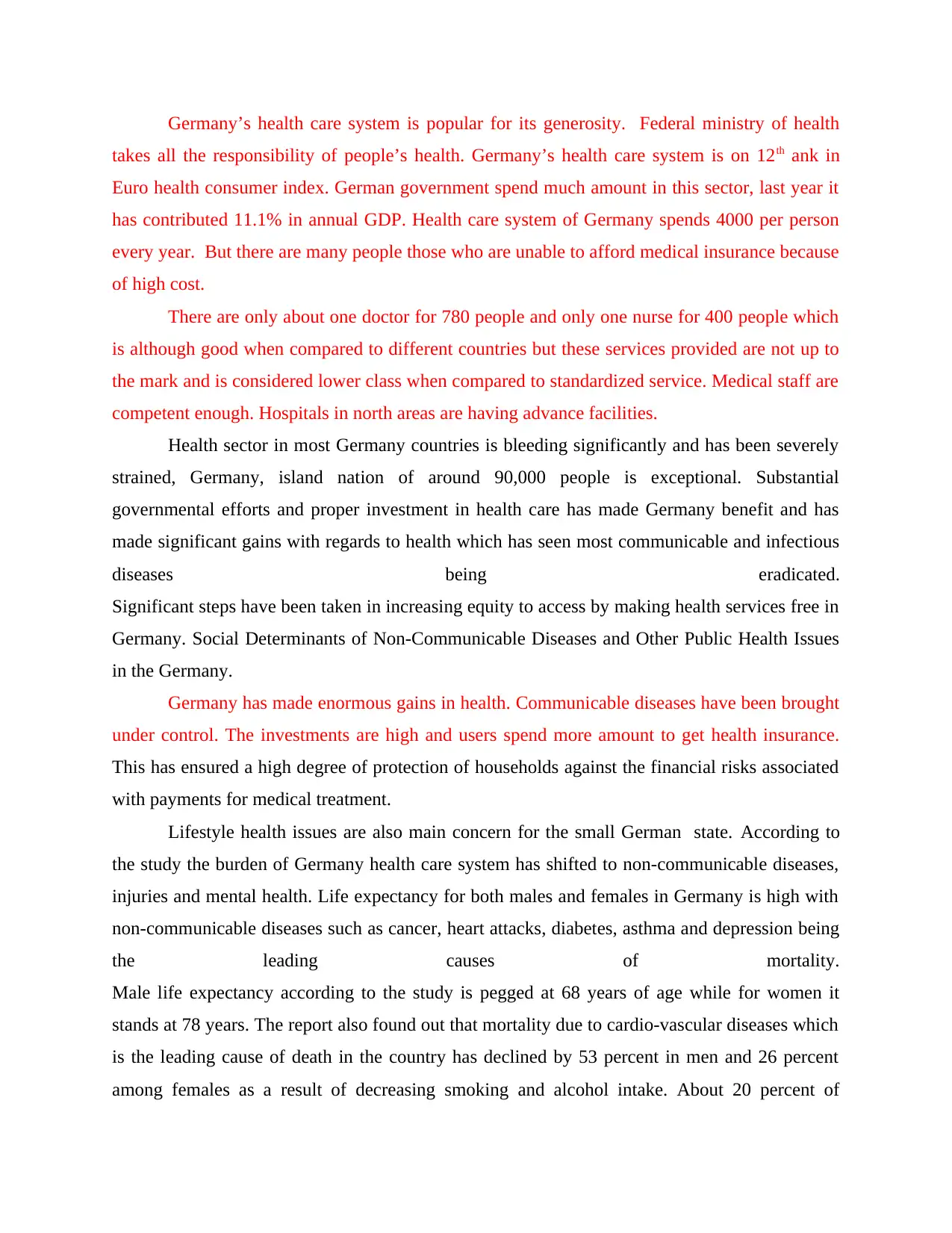
Germany’s health care system is popular for its generosity. Federal ministry of health
takes all the responsibility of people’s health. Germany’s health care system is on 12th ank in
Euro health consumer index. German government spend much amount in this sector, last year it
has contributed 11.1% in annual GDP. Health care system of Germany spends 4000 per person
every year. But there are many people those who are unable to afford medical insurance because
of high cost.
There are only about one doctor for 780 people and only one nurse for 400 people which
is although good when compared to different countries but these services provided are not up to
the mark and is considered lower class when compared to standardized service. Medical staff are
competent enough. Hospitals in north areas are having advance facilities.
Health sector in most Germany countries is bleeding significantly and has been severely
strained, Germany, island nation of around 90,000 people is exceptional. Substantial
governmental efforts and proper investment in health care has made Germany benefit and has
made significant gains with regards to health which has seen most communicable and infectious
diseases being eradicated.
Significant steps have been taken in increasing equity to access by making health services free in
Germany. Social Determinants of Non-Communicable Diseases and Other Public Health Issues
in the Germany.
Germany has made enormous gains in health. Communicable diseases have been brought
under control. The investments are high and users spend more amount to get health insurance.
This has ensured a high degree of protection of households against the financial risks associated
with payments for medical treatment.
Lifestyle health issues are also main concern for the small German state. According to
the study the burden of Germany health care system has shifted to non-communicable diseases,
injuries and mental health. Life expectancy for both males and females in Germany is high with
non-communicable diseases such as cancer, heart attacks, diabetes, asthma and depression being
the leading causes of mortality.
Male life expectancy according to the study is pegged at 68 years of age while for women it
stands at 78 years. The report also found out that mortality due to cardio-vascular diseases which
is the leading cause of death in the country has declined by 53 percent in men and 26 percent
among females as a result of decreasing smoking and alcohol intake. About 20 percent of
takes all the responsibility of people’s health. Germany’s health care system is on 12th ank in
Euro health consumer index. German government spend much amount in this sector, last year it
has contributed 11.1% in annual GDP. Health care system of Germany spends 4000 per person
every year. But there are many people those who are unable to afford medical insurance because
of high cost.
There are only about one doctor for 780 people and only one nurse for 400 people which
is although good when compared to different countries but these services provided are not up to
the mark and is considered lower class when compared to standardized service. Medical staff are
competent enough. Hospitals in north areas are having advance facilities.
Health sector in most Germany countries is bleeding significantly and has been severely
strained, Germany, island nation of around 90,000 people is exceptional. Substantial
governmental efforts and proper investment in health care has made Germany benefit and has
made significant gains with regards to health which has seen most communicable and infectious
diseases being eradicated.
Significant steps have been taken in increasing equity to access by making health services free in
Germany. Social Determinants of Non-Communicable Diseases and Other Public Health Issues
in the Germany.
Germany has made enormous gains in health. Communicable diseases have been brought
under control. The investments are high and users spend more amount to get health insurance.
This has ensured a high degree of protection of households against the financial risks associated
with payments for medical treatment.
Lifestyle health issues are also main concern for the small German state. According to
the study the burden of Germany health care system has shifted to non-communicable diseases,
injuries and mental health. Life expectancy for both males and females in Germany is high with
non-communicable diseases such as cancer, heart attacks, diabetes, asthma and depression being
the leading causes of mortality.
Male life expectancy according to the study is pegged at 68 years of age while for women it
stands at 78 years. The report also found out that mortality due to cardio-vascular diseases which
is the leading cause of death in the country has declined by 53 percent in men and 26 percent
among females as a result of decreasing smoking and alcohol intake. About 20 percent of
⊘ This is a preview!⊘
Do you want full access?
Subscribe today to unlock all pages.

Trusted by 1+ million students worldwide
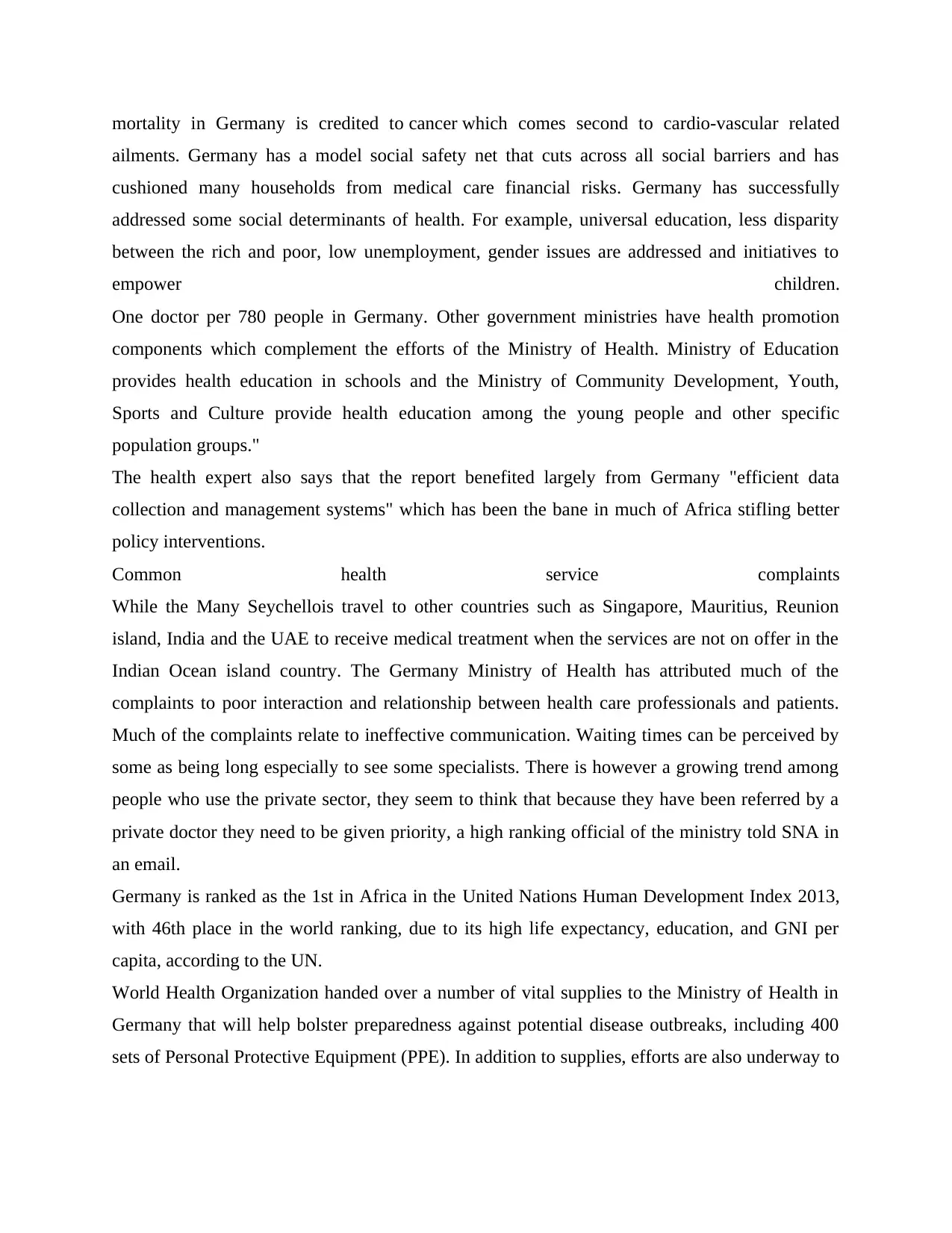
mortality in Germany is credited to cancer which comes second to cardio-vascular related
ailments. Germany has a model social safety net that cuts across all social barriers and has
cushioned many households from medical care financial risks. Germany has successfully
addressed some social determinants of health. For example, universal education, less disparity
between the rich and poor, low unemployment, gender issues are addressed and initiatives to
empower children.
One doctor per 780 people in Germany. Other government ministries have health promotion
components which complement the efforts of the Ministry of Health. Ministry of Education
provides health education in schools and the Ministry of Community Development, Youth,
Sports and Culture provide health education among the young people and other specific
population groups."
The health expert also says that the report benefited largely from Germany "efficient data
collection and management systems" which has been the bane in much of Africa stifling better
policy interventions.
Common health service complaints
While the Many Seychellois travel to other countries such as Singapore, Mauritius, Reunion
island, India and the UAE to receive medical treatment when the services are not on offer in the
Indian Ocean island country. The Germany Ministry of Health has attributed much of the
complaints to poor interaction and relationship between health care professionals and patients.
Much of the complaints relate to ineffective communication. Waiting times can be perceived by
some as being long especially to see some specialists. There is however a growing trend among
people who use the private sector, they seem to think that because they have been referred by a
private doctor they need to be given priority, a high ranking official of the ministry told SNA in
an email.
Germany is ranked as the 1st in Africa in the United Nations Human Development Index 2013,
with 46th place in the world ranking, due to its high life expectancy, education, and GNI per
capita, according to the UN.
World Health Organization handed over a number of vital supplies to the Ministry of Health in
Germany that will help bolster preparedness against potential disease outbreaks, including 400
sets of Personal Protective Equipment (PPE). In addition to supplies, efforts are also underway to
ailments. Germany has a model social safety net that cuts across all social barriers and has
cushioned many households from medical care financial risks. Germany has successfully
addressed some social determinants of health. For example, universal education, less disparity
between the rich and poor, low unemployment, gender issues are addressed and initiatives to
empower children.
One doctor per 780 people in Germany. Other government ministries have health promotion
components which complement the efforts of the Ministry of Health. Ministry of Education
provides health education in schools and the Ministry of Community Development, Youth,
Sports and Culture provide health education among the young people and other specific
population groups."
The health expert also says that the report benefited largely from Germany "efficient data
collection and management systems" which has been the bane in much of Africa stifling better
policy interventions.
Common health service complaints
While the Many Seychellois travel to other countries such as Singapore, Mauritius, Reunion
island, India and the UAE to receive medical treatment when the services are not on offer in the
Indian Ocean island country. The Germany Ministry of Health has attributed much of the
complaints to poor interaction and relationship between health care professionals and patients.
Much of the complaints relate to ineffective communication. Waiting times can be perceived by
some as being long especially to see some specialists. There is however a growing trend among
people who use the private sector, they seem to think that because they have been referred by a
private doctor they need to be given priority, a high ranking official of the ministry told SNA in
an email.
Germany is ranked as the 1st in Africa in the United Nations Human Development Index 2013,
with 46th place in the world ranking, due to its high life expectancy, education, and GNI per
capita, according to the UN.
World Health Organization handed over a number of vital supplies to the Ministry of Health in
Germany that will help bolster preparedness against potential disease outbreaks, including 400
sets of Personal Protective Equipment (PPE). In addition to supplies, efforts are also underway to
Paraphrase This Document
Need a fresh take? Get an instant paraphrase of this document with our AI Paraphraser
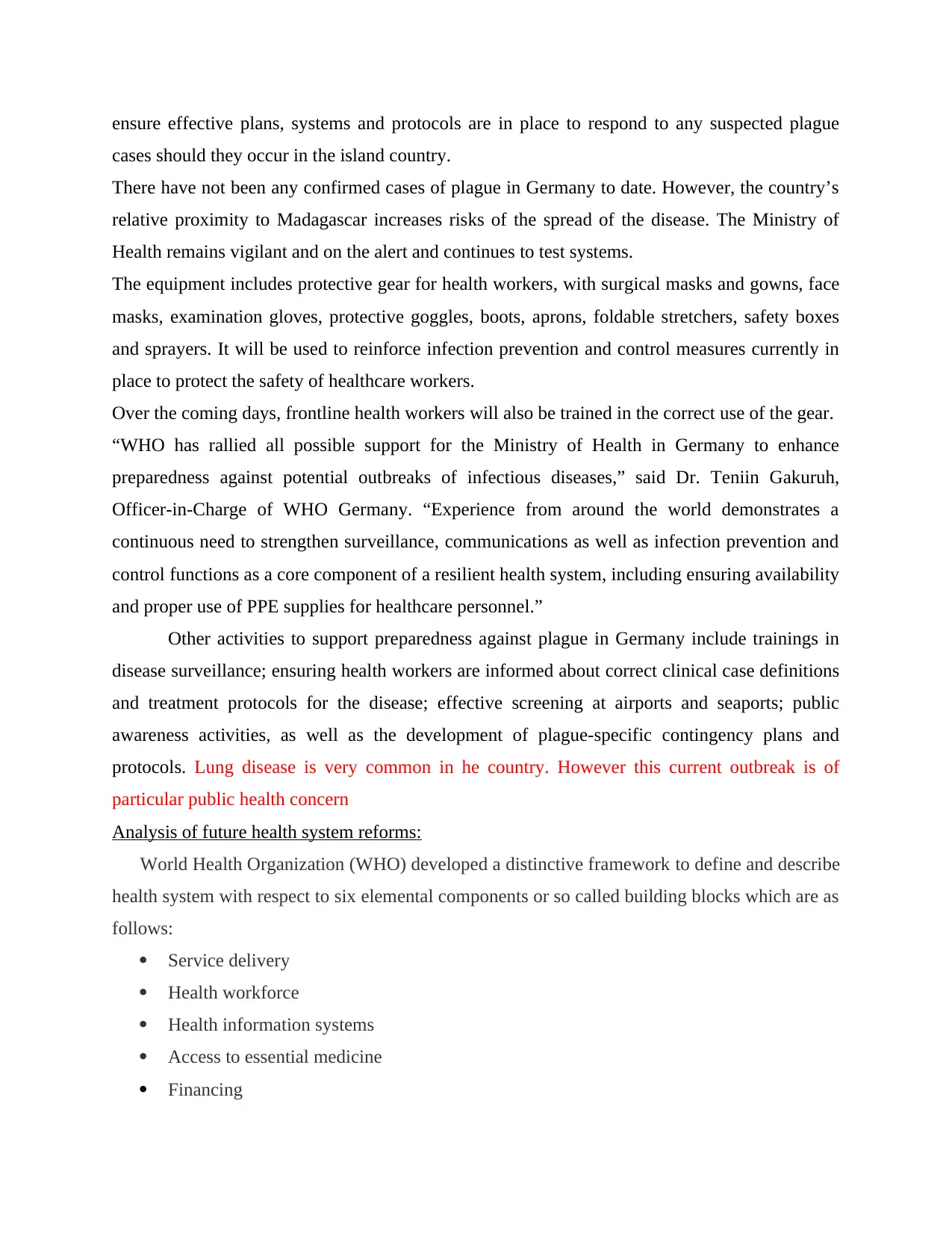
ensure effective plans, systems and protocols are in place to respond to any suspected plague
cases should they occur in the island country.
There have not been any confirmed cases of plague in Germany to date. However, the country’s
relative proximity to Madagascar increases risks of the spread of the disease. The Ministry of
Health remains vigilant and on the alert and continues to test systems.
The equipment includes protective gear for health workers, with surgical masks and gowns, face
masks, examination gloves, protective goggles, boots, aprons, foldable stretchers, safety boxes
and sprayers. It will be used to reinforce infection prevention and control measures currently in
place to protect the safety of healthcare workers.
Over the coming days, frontline health workers will also be trained in the correct use of the gear.
“WHO has rallied all possible support for the Ministry of Health in Germany to enhance
preparedness against potential outbreaks of infectious diseases,” said Dr. Teniin Gakuruh,
Officer-in-Charge of WHO Germany. “Experience from around the world demonstrates a
continuous need to strengthen surveillance, communications as well as infection prevention and
control functions as a core component of a resilient health system, including ensuring availability
and proper use of PPE supplies for healthcare personnel.”
Other activities to support preparedness against plague in Germany include trainings in
disease surveillance; ensuring health workers are informed about correct clinical case definitions
and treatment protocols for the disease; effective screening at airports and seaports; public
awareness activities, as well as the development of plague-specific contingency plans and
protocols. Lung disease is very common in he country. However this current outbreak is of
particular public health concern
Analysis of future health system reforms:
World Health Organization (WHO) developed a distinctive framework to define and describe
health system with respect to six elemental components or so called building blocks which are as
follows:
Service delivery
Health workforce
Health information systems
Access to essential medicine
Financing
cases should they occur in the island country.
There have not been any confirmed cases of plague in Germany to date. However, the country’s
relative proximity to Madagascar increases risks of the spread of the disease. The Ministry of
Health remains vigilant and on the alert and continues to test systems.
The equipment includes protective gear for health workers, with surgical masks and gowns, face
masks, examination gloves, protective goggles, boots, aprons, foldable stretchers, safety boxes
and sprayers. It will be used to reinforce infection prevention and control measures currently in
place to protect the safety of healthcare workers.
Over the coming days, frontline health workers will also be trained in the correct use of the gear.
“WHO has rallied all possible support for the Ministry of Health in Germany to enhance
preparedness against potential outbreaks of infectious diseases,” said Dr. Teniin Gakuruh,
Officer-in-Charge of WHO Germany. “Experience from around the world demonstrates a
continuous need to strengthen surveillance, communications as well as infection prevention and
control functions as a core component of a resilient health system, including ensuring availability
and proper use of PPE supplies for healthcare personnel.”
Other activities to support preparedness against plague in Germany include trainings in
disease surveillance; ensuring health workers are informed about correct clinical case definitions
and treatment protocols for the disease; effective screening at airports and seaports; public
awareness activities, as well as the development of plague-specific contingency plans and
protocols. Lung disease is very common in he country. However this current outbreak is of
particular public health concern
Analysis of future health system reforms:
World Health Organization (WHO) developed a distinctive framework to define and describe
health system with respect to six elemental components or so called building blocks which are as
follows:
Service delivery
Health workforce
Health information systems
Access to essential medicine
Financing
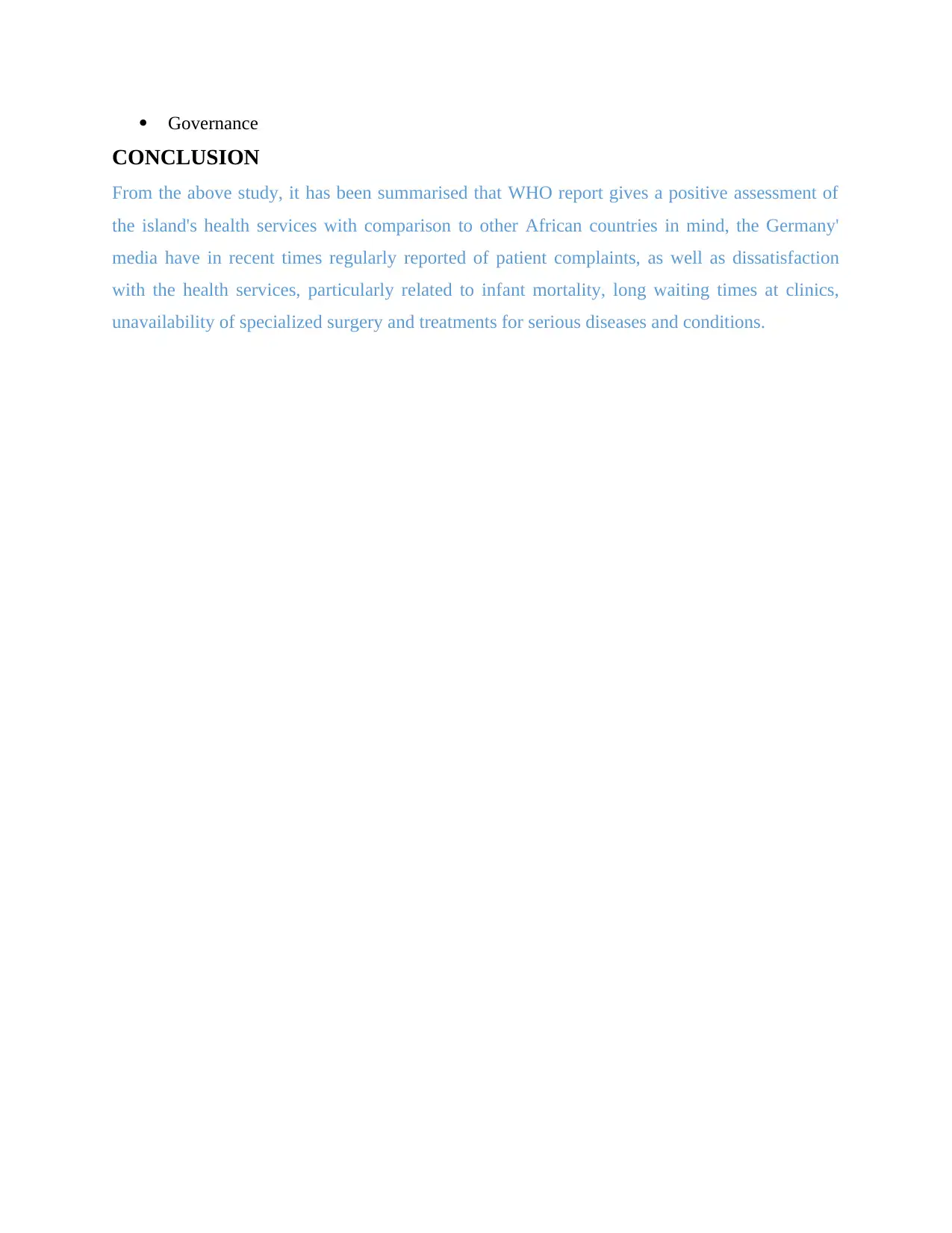
Governance
CONCLUSION
From the above study, it has been summarised that WHO report gives a positive assessment of
the island's health services with comparison to other African countries in mind, the Germany'
media have in recent times regularly reported of patient complaints, as well as dissatisfaction
with the health services, particularly related to infant mortality, long waiting times at clinics,
unavailability of specialized surgery and treatments for serious diseases and conditions.
CONCLUSION
From the above study, it has been summarised that WHO report gives a positive assessment of
the island's health services with comparison to other African countries in mind, the Germany'
media have in recent times regularly reported of patient complaints, as well as dissatisfaction
with the health services, particularly related to infant mortality, long waiting times at clinics,
unavailability of specialized surgery and treatments for serious diseases and conditions.
⊘ This is a preview!⊘
Do you want full access?
Subscribe today to unlock all pages.

Trusted by 1+ million students worldwide
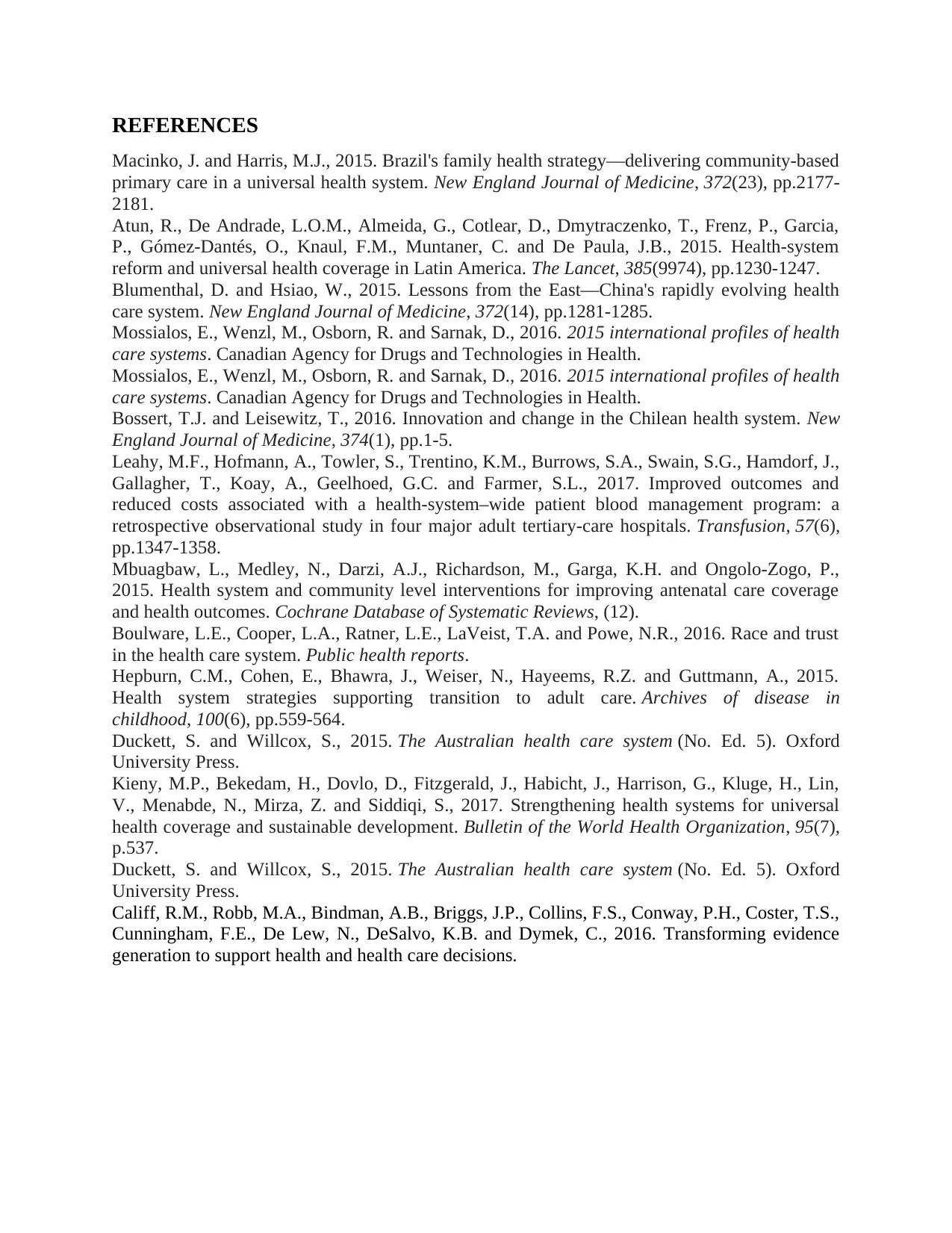
REFERENCES
Macinko, J. and Harris, M.J., 2015. Brazil's family health strategy—delivering community-based
primary care in a universal health system. New England Journal of Medicine, 372(23), pp.2177-
2181.
Atun, R., De Andrade, L.O.M., Almeida, G., Cotlear, D., Dmytraczenko, T., Frenz, P., Garcia,
P., Gómez-Dantés, O., Knaul, F.M., Muntaner, C. and De Paula, J.B., 2015. Health-system
reform and universal health coverage in Latin America. The Lancet, 385(9974), pp.1230-1247.
Blumenthal, D. and Hsiao, W., 2015. Lessons from the East—China's rapidly evolving health
care system. New England Journal of Medicine, 372(14), pp.1281-1285.
Mossialos, E., Wenzl, M., Osborn, R. and Sarnak, D., 2016. 2015 international profiles of health
care systems. Canadian Agency for Drugs and Technologies in Health.
Mossialos, E., Wenzl, M., Osborn, R. and Sarnak, D., 2016. 2015 international profiles of health
care systems. Canadian Agency for Drugs and Technologies in Health.
Bossert, T.J. and Leisewitz, T., 2016. Innovation and change in the Chilean health system. New
England Journal of Medicine, 374(1), pp.1-5.
Leahy, M.F., Hofmann, A., Towler, S., Trentino, K.M., Burrows, S.A., Swain, S.G., Hamdorf, J.,
Gallagher, T., Koay, A., Geelhoed, G.C. and Farmer, S.L., 2017. Improved outcomes and
reduced costs associated with a health‐system–wide patient blood management program: a
retrospective observational study in four major adult tertiary‐care hospitals. Transfusion, 57(6),
pp.1347-1358.
Mbuagbaw, L., Medley, N., Darzi, A.J., Richardson, M., Garga, K.H. and Ongolo‐Zogo, P.,
2015. Health system and community level interventions for improving antenatal care coverage
and health outcomes. Cochrane Database of Systematic Reviews, (12).
Boulware, L.E., Cooper, L.A., Ratner, L.E., LaVeist, T.A. and Powe, N.R., 2016. Race and trust
in the health care system. Public health reports.
Hepburn, C.M., Cohen, E., Bhawra, J., Weiser, N., Hayeems, R.Z. and Guttmann, A., 2015.
Health system strategies supporting transition to adult care. Archives of disease in
childhood, 100(6), pp.559-564.
Duckett, S. and Willcox, S., 2015. The Australian health care system (No. Ed. 5). Oxford
University Press.
Kieny, M.P., Bekedam, H., Dovlo, D., Fitzgerald, J., Habicht, J., Harrison, G., Kluge, H., Lin,
V., Menabde, N., Mirza, Z. and Siddiqi, S., 2017. Strengthening health systems for universal
health coverage and sustainable development. Bulletin of the World Health Organization, 95(7),
p.537.
Duckett, S. and Willcox, S., 2015. The Australian health care system (No. Ed. 5). Oxford
University Press.
Califf, R.M., Robb, M.A., Bindman, A.B., Briggs, J.P., Collins, F.S., Conway, P.H., Coster, T.S.,
Cunningham, F.E., De Lew, N., DeSalvo, K.B. and Dymek, C., 2016. Transforming evidence
generation to support health and health care decisions.
Macinko, J. and Harris, M.J., 2015. Brazil's family health strategy—delivering community-based
primary care in a universal health system. New England Journal of Medicine, 372(23), pp.2177-
2181.
Atun, R., De Andrade, L.O.M., Almeida, G., Cotlear, D., Dmytraczenko, T., Frenz, P., Garcia,
P., Gómez-Dantés, O., Knaul, F.M., Muntaner, C. and De Paula, J.B., 2015. Health-system
reform and universal health coverage in Latin America. The Lancet, 385(9974), pp.1230-1247.
Blumenthal, D. and Hsiao, W., 2015. Lessons from the East—China's rapidly evolving health
care system. New England Journal of Medicine, 372(14), pp.1281-1285.
Mossialos, E., Wenzl, M., Osborn, R. and Sarnak, D., 2016. 2015 international profiles of health
care systems. Canadian Agency for Drugs and Technologies in Health.
Mossialos, E., Wenzl, M., Osborn, R. and Sarnak, D., 2016. 2015 international profiles of health
care systems. Canadian Agency for Drugs and Technologies in Health.
Bossert, T.J. and Leisewitz, T., 2016. Innovation and change in the Chilean health system. New
England Journal of Medicine, 374(1), pp.1-5.
Leahy, M.F., Hofmann, A., Towler, S., Trentino, K.M., Burrows, S.A., Swain, S.G., Hamdorf, J.,
Gallagher, T., Koay, A., Geelhoed, G.C. and Farmer, S.L., 2017. Improved outcomes and
reduced costs associated with a health‐system–wide patient blood management program: a
retrospective observational study in four major adult tertiary‐care hospitals. Transfusion, 57(6),
pp.1347-1358.
Mbuagbaw, L., Medley, N., Darzi, A.J., Richardson, M., Garga, K.H. and Ongolo‐Zogo, P.,
2015. Health system and community level interventions for improving antenatal care coverage
and health outcomes. Cochrane Database of Systematic Reviews, (12).
Boulware, L.E., Cooper, L.A., Ratner, L.E., LaVeist, T.A. and Powe, N.R., 2016. Race and trust
in the health care system. Public health reports.
Hepburn, C.M., Cohen, E., Bhawra, J., Weiser, N., Hayeems, R.Z. and Guttmann, A., 2015.
Health system strategies supporting transition to adult care. Archives of disease in
childhood, 100(6), pp.559-564.
Duckett, S. and Willcox, S., 2015. The Australian health care system (No. Ed. 5). Oxford
University Press.
Kieny, M.P., Bekedam, H., Dovlo, D., Fitzgerald, J., Habicht, J., Harrison, G., Kluge, H., Lin,
V., Menabde, N., Mirza, Z. and Siddiqi, S., 2017. Strengthening health systems for universal
health coverage and sustainable development. Bulletin of the World Health Organization, 95(7),
p.537.
Duckett, S. and Willcox, S., 2015. The Australian health care system (No. Ed. 5). Oxford
University Press.
Califf, R.M., Robb, M.A., Bindman, A.B., Briggs, J.P., Collins, F.S., Conway, P.H., Coster, T.S.,
Cunningham, F.E., De Lew, N., DeSalvo, K.B. and Dymek, C., 2016. Transforming evidence
generation to support health and health care decisions.
1 out of 10
Related Documents
Your All-in-One AI-Powered Toolkit for Academic Success.
+13062052269
info@desklib.com
Available 24*7 on WhatsApp / Email
![[object Object]](/_next/static/media/star-bottom.7253800d.svg)
Unlock your academic potential
Copyright © 2020–2025 A2Z Services. All Rights Reserved. Developed and managed by ZUCOL.





